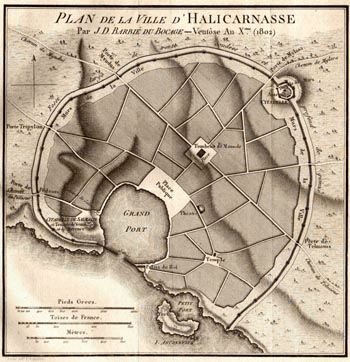Alexander's Campaign > Siege of Halicarnassus
Siege of Halicarnassus
Siege of Halicarnassus
Part of the Persian Campaign

Halicarnassus Map (1802)
Date: 334 BC
Location: Halicarnassus, Caria
Coordinates: 37.0333°N 27.4333°E
Aftermath: Macedonian victory
Territorial Changes: Alexander gains Caria
Next Battle: Battle of Issus
Previous Battle: Siege of Miletus
Background
The Siege of Halicarnassus was a battle fought in 334 BC at the city of Halicarnassus between the Macedonians and the Achaemenid Empire during the Persian Campaign of Alexander III the Great.
The Greek kingdom of Ionia had long been a vassal state of the Persians due to its location in Asia. Previous rulers of Caria going back many centuries had been allies of the Achaemenids in their conquest of Greece during the Greco-Persian Wars and naturally it was a target of Alexander during his campaign.
Before Alexander arrived in Halicarnassus there was much political turmoil that left the situation ripe for Alexander to take advantage of. The previous queen of Caria named Ada of Caria had been dethroned by her younger brother Pixodarus. When Pixodarus died he was replaced as ruler by Darius III with a satrap named Orontobates.
As Alexander's army moved through Caria he encountered the city of Alinda where Ada was residing. She promptly surrendered the fortress to him and he began his conquest forward towards Halicarnassus, gaining Ada as a political ally in the process.
The Siege
From there Orontobates and Memnon began to reinforce Halicarnassus and brace for the inevitable siege as they had no plans to turn against Darius III. Alexander had learned from his spies there were dissidents in the city that would be willing to assist his siege and open the city gates. He agreed to send several spies to meet the rebels who would ensure the plan went smoothly.
However, upon arrival at the location the rebels were nowhere to be found and the spies were ambushed by the Persians. A small skirmish erupted in Halicarnassus whereupon Alexander's army began a full siege that managed to break through the city walls quickly. However, at this point the Persians activated their defenses and massive catapults almost forced the soldiers to retreat. As Memnon moved his infantry into position to chase the Macedonians back across the Hellespont the forces of Alexander broke through the walls and surprised the Persians.
Realizing the city was gone he ordered everything burned and ordered a retreat of the Persian military from the city. The weather that day caused the fire to erupt into an inferno with the strong winds and much of the city was destroyed, yet the territory of Caria was fully in control of Alexander. In return for her assistance, Ada was restored to the throne and became an ally of Alexander.
Aftermath
In fact, she appreciated Alexander so much that she formally adopted him so that when she died the rule over Caria would naturally pass onto him. Since Ada enjoyed much popular favor this would thus transfer onto Alexander and ensure that the allegiance of the kingdom of Caria permanently switched in Alexander's favor. Overall, this was one of the closest points that Alexander came to defeat and may have put an early end to his campaign if not for the valiant efforts of the Macedonian soldiers.
Battle Summary:
| Combatants | |
|---|---|
| Achaemenid Empire | |
| Commanders | |
| Orontobates | |
| Hepaestion | Memnon of Rhodes |
| Military Forces | |
| Unknown | Unknown |
| Casualties | |
| Unknown | Unknown |
Sources
Cartledge, Paul. Alexander the Great: The Hunt for a New Past. Woodstock, NY; New York: The Overlook Press, 2004 (hardcover, ISBN 1-58567-565-2); London: PanMacmillan, 2004 (hardcover, ISBN 1-4050-3292-8); New York: Vintage, 2005 (paperback, ISBN 1-4000-7919-5).